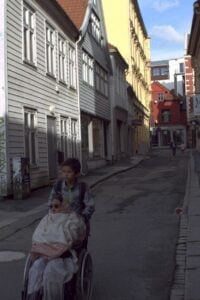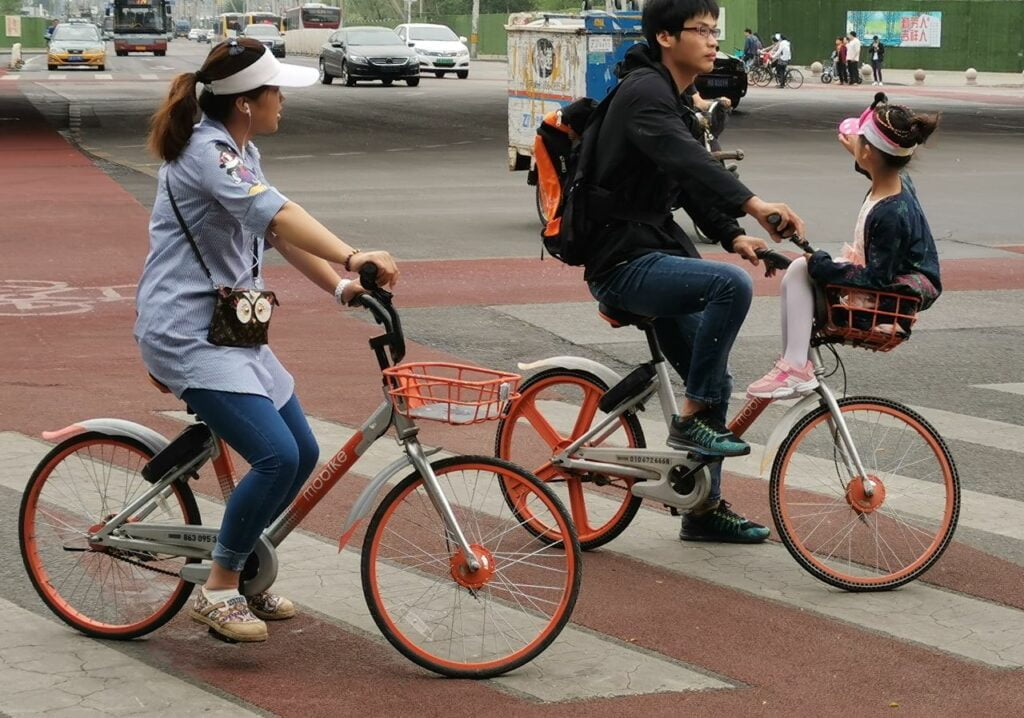The Illusion of Inclusion: Cities through a gender lens
Why Smart Cities and Smart Mobilities might not turn out to be smart for all, by Tanu Priya Uteng PhD, Hilda Rømer Christensen PhD and Lena Levin PhD
The gender lens provides a vantage point to address the agenda of creating inclusive cities.
Transport planning to date remains a heavily male-dominated domain, and the needs and preferences of women are often ignored in the current framework of city planning built primarily around the car. Prioritising walking, cycling, better accessibility to public transport, functioning first- and last-mile connectivity and personal security are some of the basic modules to support inclusive mobility.
Yet too often, these basics are not in place. There is ample evidence of male dominance of the transport sector, both when it comes to decision-making and knowledge production. A 2019 mapping of transport ministers in nine European countries shows that since 1945, only twenty-three out of a total of 245 ministers have been women. Most of them have had limited impact because they have only been in office for shorter periods (Christensen and Breengaard, 2020).
This is echoed by the parliamentary transport committees across Europe where female representation in 2019 varied between 7% and 40%. Even in Sweden with a higher level of gender balance in the transport committees, this does not guarantee a substantial change in policy (Levin and Faith-Ell, 2019; Levin and Thoresson, 2020). At the same time, the discipline is veering towards smart cities and smart mobilities, which often have nothing to do with the semantics of the word ‘smart’ and is primarily focused on digitalisation, automation and sharing.
Imaginations of smart mobility at present are being led by producers and manufactures promoting an optimistic vision of a society in which technological advances will deliver a “benign mobility system that all users can access seamlessly and on demand” (Marsden & Reardon 2017). But the current field of smart transport, not least the dream of driverless cars and other vehicles, is marked by strong (male) fascinations and fantasies, and tends to apply the technological fix as the solution to climate and sustainability challenges (Christensen and Breengaard 2019).
Another challenge is that the knowledge that has so far been created on ‘gender and diversity’ in transport planning does not seem to have had any substantial impact (Transgen, 2007; Priya Uteng and Cresswell, 2008). There is plenty of evidence that policy and planning are still in a circuit of knowledge produced by a neo-classical, growth-oriented, genderless, sustainable paradigm. A critical paradigm, which highlights the structural inequalities in terms of privilege and disadvantages related to gender and other categories in transport and mobility, is weak or absent from political agendas (Kębłowski & Bassens 2018). Climate change has lately become a hot policy topic, partly generated by younger generations and a revitalisation of critical social movements. This seems to be promising for a game change in the circuit of transport and mobility and new knowledge production.
It is thus critically important that we take a pause to reflect on both the logics and implementation of ‘smart’ solutions that are leaving important social issues unattended. While the possibilities, technical detailing and effectiveness of smart solutions are being celebrated, research studies confirm the exclusive nature of the smart solutions. Gender emerges as a strong contender in this broad domain of exclusivity. We fear that gender as a category, once again, will come as an afterthought to the entire (smart) conceptualisation, planning and execution, and it might be too late to make amends.
Gendering Smart Mobilities, our joint publication, attempts to shift the prevailing technical focus to other equally important themes like inclusive solutions, governance and livelihood. We examine the nature of mobility solutions being proposed, the relationship between the so-called smart solutions and societal conditions, their mutual interactions over time, weaving through the macro and micro determinants for individual attitudes and behaviour. For example, how can we steer away from the primacy of time-saving logics over activity participation, and map the social ramifications of spatial (and transport) decisions?
 The publication intends to challenge existing power positions both in knowledge production and policy making. It explores the connections between the fields of gender and smart transport including the place of emotions, and power in smart mobilities. Questions like "Will the self-driving car loosen the hierarchical and gendered script of the cars and prevailing strong bonds of men, masculinity and cars?" have also been explored (Balkmar and Mellström, 2020). It is hoped that this volume can both feed and spur new avenues and a stronger sensitivity to diversity, justice and wellbeing in transport and mobility.
The publication intends to challenge existing power positions both in knowledge production and policy making. It explores the connections between the fields of gender and smart transport including the place of emotions, and power in smart mobilities. Questions like "Will the self-driving car loosen the hierarchical and gendered script of the cars and prevailing strong bonds of men, masculinity and cars?" have also been explored (Balkmar and Mellström, 2020). It is hoped that this volume can both feed and spur new avenues and a stronger sensitivity to diversity, justice and wellbeing in transport and mobility.
An unsmart reality
Biking and bike-sharing seem to be a perfect match for both smart mobility and current climate change policies. However, studies from around the world highlight both gender sensitive potentials as well as limitations in the actual use and provision of services. For example, in its initial stages, China’s Mobike was promising both as a gendered innovation and as part of smart city development, which could meet both transport needs along with curbing CO2 emissions (Christensen 2020), but a number of system deficits were eventually visible which specifically affected women.
Some of these issues were: safety measures, pricing, easy online access, women-friendly designs and the possibility of transporting family members – especially children. Analysing London’s ‘cycling revolution’ highlights ways in which the cycling paradigm reflects an implicit male-focused bias in the design, delivery, and discourses of cycling infrastructure in the city.
The proposed interventions raise the profile of already visible privileged cyclists (white middle-class men) for whom cycling is a lifestyle choice while erasing ‘invisible cyclists’ (Lam 2020). Oslo’s bike sharing scheme is another case in point (Priya Uteng et. al. 2020). Examining the gendered variations of the practices, design and performance of bike sharing system revealed that men were active users and women were catching up as and when the system responded to their needs. These needs, first and foremost, were simply about the availability of docking stations and shared bikes in areas with high share of female employment and residence. These areas corresponded with peripheral locations whereas shared bikes were concentrated in Oslo’s downtown.
Data on the use of car sharing further reveals that the system is being used by a relatively small proportion of women. By contrast, ‘ride-hailing’ operators such as Lyft or Uber indicate a heavy usage by women (Dogtiev, 2017). This sits well with the knowledge we have on women’s mobility patterns – short trips, linking multiple trip purposes and destinations, escort trips, and accessing places not served by traditional public transport routes or schedules.
The European Union and its aligned agencies endorse themselves as leading parties in the development of what is now called CAD, Connected and Automated Driving. Smart cars are being envisioned as a solution that can avoid many of the evils of today’s conditions. Smart car mobility will, according to such optimistic lines, bring massive gains in safety, cost reduction, and infrastructures and vehicles will be used more efficiently. What is more, the smart mobility solutions are predicted to bring much greater consumer choice due to shared ownership, data aggregation, and peer-to-peer mobility that reduces the grip of large providers (Viechnicki et. al. 2015).
According to ERTRAC, automated driving innovation is motivated by both technological advancements as well as social goals: Automated driving is endorsed as “one of the key technologies and major technological advancements influencing and shaping out future mobility and equality of life” (ERTRAC 2019: 4). However, based on a survey collecting gendered responses data on the adoption and use of emerging mobility options in the Greater Phoenix Metropolitan Area, Capasso da Silva et al (2019) found that women are less likely to adopt shared rides in autonomous vehicle (AV) ride-hailing services with unfamiliar passengers. For the eventual deployment of shared AVs, the authors emphasize: (i) the need to develop safety protocols and targeted campaigns for enhancing women’s willingness to share AV rides, and (ii) special services such as female-only services to enhance automated mobility acceptance.
Moving Forward
 The core message emerging from fixing the jigsaw puzzle of women’s daily trip patterns and the current deployment and usage of smart mobility, is that smart solutions such as car-sharing and bike-sharing should not be implemented without linking them with the inherent context. Questions such as “Who are the potential users of a particular solution?” need to be addressed before launching a scheme.
The core message emerging from fixing the jigsaw puzzle of women’s daily trip patterns and the current deployment and usage of smart mobility, is that smart solutions such as car-sharing and bike-sharing should not be implemented without linking them with the inherent context. Questions such as “Who are the potential users of a particular solution?” need to be addressed before launching a scheme.
Simultaneously, digital solutions provide ample opportunities to both collect data and undertake new kinds of data analyses. Before launching smart cities/mobility projects, studies employing both traditional methods such as focus groups/questionnaire surveys/measuring actual behavioural response to different measures, and new methods such as mobile app-based data collection, should be undertaken to understand the existing travel behaviour and adaptive preferences of different groups. Studies conducted along these lines (e.g. Gärling et al., 2000, Loukopoulos et al., 2004 and Loukopoulos et al., 2005) have found that discretionary trips have a greater number of adaptation alternatives available from which to choose than non-discretionary work trips do.
This is applicable to the case of gendered mobilities, where a major share of women’s trips caters to discretionary purposes of combining various household/social/shopping-related purposes.
Though the following list is not exhaustive and needs to be routinely updated, analyses of travel behaviour, constraints and accessibility can be bolstered by fusing the following quantitative and qualitative data collection techniques:
- Travel survey data enriched with spatial data
- Attitudinal and preference survey
- Multi-sited ethnography combined with in-depth traveller interviews
- Document analysis and informant interviews
- Accessibility mapping
Travel survey data enriched with spatial data
Modules are already available to extract entire travel diaries by accessing the smartphone data. This data can be further enriched through linking to spatial data such as Open Street Maps, and census, register and cadastral data.
Attitudinal and preference survey
Attitudinal and preference travel survey will assist in capturing habits, attitudes, well-being, perceived barriers and motivations with regard to the access to health, education, and employment opportunities (Ettema et. al. 2010). Background information on personal and household attributes, preferences and lifestyles with regard to themes such as mobility, access to important nodes, etc., should also be collected as part of this exercise.
Multi-sited ethnography combined with in-depth traveller interviews
This is necessary to provide a full understanding of mobility experiences, barriers and motivations underlying the decision-making process of route choice, access, egress and transfer practices. Such knowledge will further ensure that key questions are identified for designing smart solutions. Understanding the time budget will clarify how employed women’s unpaid household work and responsibilities can be supported through smart accessibility solutions (Scholten et. al. 2012).
Document analysis and informant interviews
Key informants – including politicians, policy makers, the local and regional authorities, and ministry officials involved in decision making on smart agendas – should be engaged to shed light on how decisions on smart cities are being made. This is a necessary step in designing truly smart solutions for all.
Accessibility mapping
Transport modelling approach is dominated by the logics of travel-time savings that underpin major transport infrastructure projects. We propose that mapping of the interactions between accessibility with different transport modes to different land uses, and facilities such as schools, employment and health centres, be undertaken to inform the design and implementation of transport infrastructure such as public transport routes, bicycle networks, etc.
Summing up
The ‘smart’ agenda needs to actually look up the dictionary meaning of the word smart. After this relatively simple job is done, we urge that the technical focus embedded in the smart agenda is steered towards becoming more ‘inclusive’. It is thus important that the conceptual foundation of quality-of-life (QOL) and subjective well-being (SWB) be employed to inform the framing of future smart agenda. Such shifts will aid in identifying and estimating the links between gender, time use, travel time, and the extent to which the overall quality of life is affected by smart solutions. Sweet and Kanaroglou (2016) find that travel times serve as inputs in activity participation and therefore – at least for women – indirectly contribute to higher levels of SWB.
These findings suggest that focusing on activity participation as a chief policy objective in transportation planning could yield higher quality-of-life benefits than a policy focus on travel-time savings (ibid:10). Finally, we insist that upcoming and proposed smart solutions be analysed with this framework in mind and build on increasing accessibility (rather than mobility) to key destinations supporting livelihood, health and education.
Authors: Tanu Priya Uteng PhD. is senior researcher in the department of Sustainable Urban Development and Mobility, at the Institute of Transport Economics (TOI) in Oslo, Norway. Email: tpu@toi.no Hilda Rømer Christensen PhD. is associate professor and Head of Co-Ordination for Gender Studies, University of Copenhagen. Email: hrc@soc.ku.dk Lena Levin PhD. is senior researcher in the department of Mobility, Actors and Planning processes (MAP) at the Swedish National Road and Transport Research Institute (VTI). Email: lena.levin@vti.se
References:
Balkmar, D. and Mellstrom, U. (2020) Towards an anthropology of transport affect: the place of emotions, gender, and power in smart mobilities, in T. Priya Uteng, H. Rømer Christensen and L. Levin, (Eds.) Gendering Smart Mobilities (Abingdon and New York: Routledge)
Capasso da Silva, D., Khoeini, S. and Pendyala, R.M. (2019), The effect of attitudes on women’s willingness to share autonomous vehicles, Paper presented at the 6th International Conference on Women’s Issues in Transportation (WIiT 2019), September 10–13, Irvine, California
Christensen, H.R. (2020) Smart biking as gendered innovations and smart city experiment? The case of Mobike in China, in T. Priya Uteng, H. Rømer Christensen and L. Levin, (Eds.) Gendering Smart Mobilities (Abingdon and New York: Routledge)
Christensen, H.R. and Breengaard, M.H (forthcoming) Gender Smart Transport. Translating theory into practice. TINNGO Road Map (Innovation Gender Observatory mobility. EU Horizon 2020 project)
Dogtiev, Artyom (2017): Uber Revenue and Usage Statistics. Available at: http://www.businessofapps.com/data/uber-statistics/ ERTRAC (2019) Connected Automated Driving Roadmap (Bruxelles, Belgium: European Road Transport Research Advisory Council). Available at: https://www.ertrac.org/uploads/documentsearch/id57/ERTRAC-CAD-Roadmap-2019.pdf
Gärling, T., Olsson, L. E., & Friman, M. (2010). Out-of-home activities, daily travel, and subjective well-being. Transportation Research Part A: Policy and Practice, 44(9), 723–732
Kębłowski, W. and Bassens, D. (2018) “All transport problems are essentially mathematical”: The uneven resonance of academic transport and mobility knowledge in Brussels, Urban Geography, 39:3, 413-437.
Lam, T. (2020) Cycling London: an intersectional feminist perspective, in T. Priya Uteng, H. Rømer Christensen and L. Levin (Eds.) Gendering Smart Mobilities (Abingdon and New York: Routledge)
Lenz, B. (2020) Smart mobility – for all? Gender issues in the context of new mobility concepts, in T. Priya Uteng, H. Rømer Christensen and L. Levin, (Eds.) Gendering Smart Mobilities (Abingdon and New York: Routledge)
Levin, L. and Faith-Ell, C. (2019). How to apply Goals for Gender Equality in Transport and Infrastructure Planning. In Lindqvist Scholten, C. and Joelsson, T. Integrating Gender into Transport Planning – From One to Many Tracks, pp. 89–118. Palgrave MacMillan.
Levin, L. and Thoresson, K. (2020) How to integrate gender equality in the future of “smart” mobility: a matter for a changing planning practice, in T. Priya Uteng, H. Rømer Christensen and L. Levin, (Eds.) Gendering Smart Mobilities, pp. 143–161. (Abingdon and New York: Routledge)
Loose, Willi (2010): Aktueller Stand des Car-Sharing in Europa. Endbericht D 2.4 Arbeitspaket 2; Bundesverband CarSharing e.V. Available at:: http://www.carsharing.info/images/stories/pdf_dateien/wp2_endbericht_deutsch_final_4.pdf
Loukopoulos, P., Jakobsson, C., Gärling, T., Meland, S. and Fujii, S. (2005) Choices of activity- and travel-change options for reduced car use, in H. Timmermans (Ed.) Progress in Activity-Based Analysis, Elsevier, PP. 481–501 Marsden, G. and Reardon, L. (2017) Questions of governance: rethinking the study of transportation policy, Transport. Res. Part A: Pol. Pract., 101, pp. 238-251
Priya Uteng, T. and Cresswell, T. (2008) Gendered Mobilities. London and New York: Routledge. Priya Uteng, T., Espegren, H.M., Throndsen T.S. and Bocker, L. (2020) The Gendered Dimension of Multi-Modality: Exploring the Bike Sharing Scheme of Oslo, in T. Priya Uteng, H. Rømer Christensen and L. Levin (Eds.) Gendering Smart Mobilities (Abingdon and New York: Routledge)
Scholten, C., Friberg, T., and Sandén, A. (2012). Re-reading time-geography from a gender perspective: examples from gendered mobility. Tijdschrift voor Economische en Sociale Geografie, 103(5): 584–600
Transgen (2007) Gender Mainstreaming European Transport Research and Policies, Building the knowledge base and mapping good practices. Copenhagen: University of Copenhagen.
Viechnicki, P., Khuperkar, A., Fishman, T.D. and Eggers, W.D. (2015) Smart mobility: Reducing congestion and fostering faster, greener, and cheaper transportation options, Available at: https://www2.deloitte.com/insights/us/en/industry/public-sector/smart-mobility-trends.html
